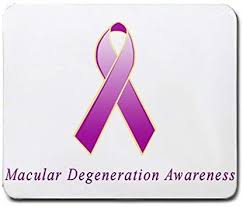
February is national age-related macular degeneration (AMD) and low vision awareness month.
AMD is the leading cause of low vision and blindness in Americans age 60 years and older and affects 1.6 million Americans.
As the Baby Boomer generation ages, the rates of AMD are expected to reach “epidemic proportions”.
The exact cause of AMD is not known. But there are a number of risk factors that may play a role. Some you can help control, some you can’t. The same things that put you at risk for heart disease and stroke also put you at risk for AMD. These include:
- High blood pressure
- High cholesterol
- Obesity
- Smoking
- Risks you cannot control include age, family history, gender and race.
Symptoms
AMD symptoms include blurriness, wavy lines, or a blind spot. You may also notice visual distortions such as:
- Straight lines or faces appearing wavy
- Doorways seeming crooked
- Objects appearing smaller or farther away
If you notice any of these symptoms, you should see an ophthalmologist as soon as possible. If you are diagnosed with wet AMD, it is important to see a Retina Specialist for the most appropriate care
Following a Mediterranean diet may help reduce the risk for AMD.
Even though there is no known cure for AMD, practicing healthy daily lifestyle habits can reduce your risk for it. A healthy diet, not smoking, and maintaining healthy blood pressure are important first steps. Other healthy habits that can lower the risk of AMD include:
- Eat a diet with plenty of green, leafy vegetables such as kale, spinach, and collard greens, and fresh fruit.
- Fish that are high in omega-3 fatty acids are good for eye health. Try to include it in your diet at least once or twice a week. Types of fish that are high in omega-3 fatty acids include salmon, sardines, mackerel, herring, and albacore tuna.
- It’s important to keep your body healthy. Maintain a healthy weight, exercise regularly, maintain healthy blood pressure and cholesterol levels. The healthier your body, the more it can foster good eye health.
- Protect your eyes. Wear sunglasses and a hat with a visor in bright sunlight to protect your eyes from potentially harmful ultra-violet (UV) light and blue light.
Not everyone with AMD develops late AMD or gets it in both eyes. But if you do, living with vision loss from AMD can be challenging.
Vision loss from macular degeneration can affect your ability to do things such as read, recognize faces, and drive. These tips may help you cope with your changing vision:
- Ask your eye doctor to check your eyeglass prescription. If you wear contacts or glasses, be sure your prescription is up to date. If new glasses don’t help, ask for a referral to a low vision specialist.
- Use magnifiers. A variety of magnifying devices can help you with reading and other close-up work such as sewing. Such devices include hand-held magnifying lenses or magnifying lenses you wear like glasses. You may also use a closed-circuit television system that uses a video camera to magnify reading material and project it on a video screen.
- Change your computer display and add audio systems. Adjust the font size in your computer’s settings and just your monitor to show more contrast. You may also add speech-output systems or other technologies to your computer.
- Use electronic reading aids and a voice interface. Try large-print books, tablet computers, and audiobooks. Some tablet and smartphone apps are designed to help people with low vision. Many of these devices now come with a voice recognition feature.
- Select special appliances made for low vision. Some clocks, radios, telephones, and other appliances have extra-large numbers. You may find it easier to watch a television with a larger high-definition screen or you may want to sit closer to the screen.
- Use brighter lights in your home. Better lighting helps with reading and other daily activities and it may also reduce the risk of falling.
- Consider your transportation options. If you drive check with your doctor to see if it’s safe to continue doing so. Be extra cautious in certain situations such as driving at night, in heavy traffic or in bad weather. Use public transportation or ask a friend or family member to help especially with night driving. Make arrangements to use local van or shuttle services, volunteer driving networks or rideshares.
- Get support. Having macular degeneration can be difficult and you may need to make changes in your life. You may go through many emotions as you adjust. Consider talking to a counselor or joining a support group. Spend time with supportive family members and friends.
Even after receiving a diagnosis of wet macular degeneration, you can take steps that may help slow vision loss.
- Don’t smoke. If you smoke ask your doctor for help to quit.
- Choose a healthy diet. The antioxidant vitamins in fruits and vegetables contribute to eye health. Kale, spinach, broccoli, squash, and other vegetables have high levels of antioxidants including lutein and zeaxanthin which may benefit people with macular degeneration. Foods containing high levels of zinc also may be of particular value in patients with macular degeneration. These include high-protein foods such as beef, pork, and lamb. Nonmeat sources include milk, cheese, yogurt, whole-grain cereals, and whole-wheat bread. Another good choice is healthy unsaturated fats, such as olive oil. Research studies have shown that a diet high in omega-3 fatty acids such as those found in salmon, tuna, and walnuts, may lower the risk of advanced macular degeneration. But the same benefit is not shown from taking omega-3 supplements such as fish oil capsules.
- Manage your other medical conditions. For example, if you have cardiovascular disease or high blood pressure take your medication and follow your doctor’s instructions for controlling the condition.
- Maintain a healthy weight and exercise regularly. If you need to lose weight, reduce the number of calories you eat and increase the amount of exercise you get each day
- Have routine eye exams. Ask your eye doctor about the recommended schedule for follow-up exams. In between checkups, you can do a self-assessment of your vision using an Amsler grid or by using the ForeseeHome AMD Monitoring Program.
- Improve the lighting in your home and office. This may not necessarily mean that you should increase the lighting or the brightness, but instead reduce the glare, which is often a problem for people with low vision.
- Use high contrast for reading and writing. Write in large letters with a broad felt tip pen on white or light paper.
- Use large print books or try other media, like books on CDs or an e-reader.
- Use a handheld magnifier.
For more information please visit www. macularhope.org
